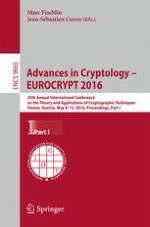2016 | OriginalPaper | Buchkapitel
Reusable Fuzzy Extractors for Low-Entropy Distributions
verfasst von : Ran Canetti, Benjamin Fuller, Omer Paneth, Leonid Reyzin, Adam Smith
Erschienen in: Advances in Cryptology – EUROCRYPT 2016
Verlag: Springer Berlin Heidelberg
Aktivieren Sie unsere intelligente Suche, um passende Fachinhalte oder Patente zu finden.
Wählen Sie Textabschnitte aus um mit Künstlicher Intelligenz passenden Patente zu finden. powered by
Markieren Sie Textabschnitte, um KI-gestützt weitere passende Inhalte zu finden. powered by
